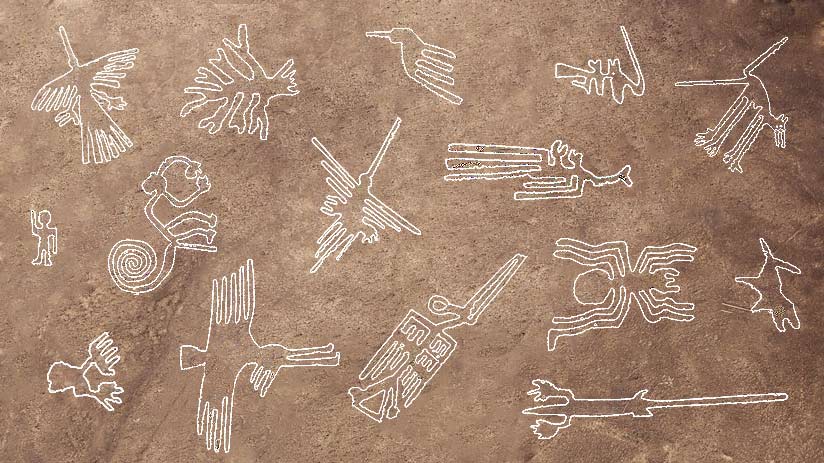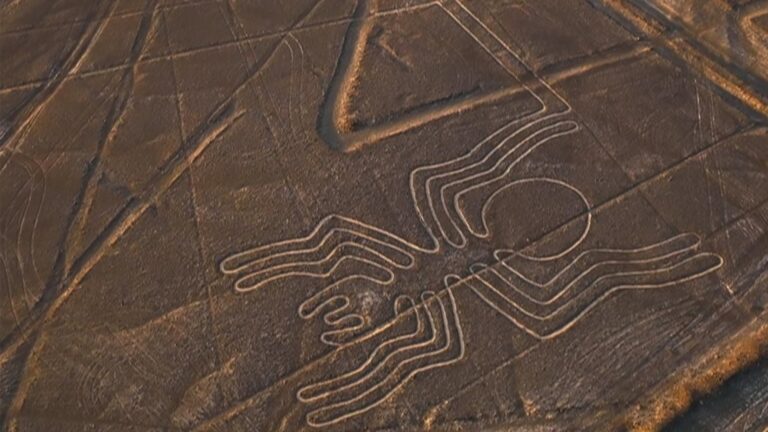In the desolate and arid expanse of the Peruvian desert, an ancient riddle is etched into the very earth itself—the Nazca Lines. These colossal geoglyphs, a network of intricate and colossal designs, have stood as a testament to human ingenuity and creativity for over a thousand years. Scattered across nearly 200 square miles of the Nazca Plateau, these enigmatic markings depict animals, plants, and geometric shapes of astonishing scale. Yet, their true purpose and the mysteries they hold have eluded us for centuries. In this journey through time and terrain, we delve deep into the mysteries of the Nazca Lines, peeling back the layers of history, exploring the multitude of theories, and unveiling recent breakthroughs that illuminate this ancient enigma.
Though celebrated today as a marvel of human achievement, were not immediately brought to the world’s attention. It was not until the early 20th century that they were discovered by Peruvian archaeologist Toribio Mejía Xesspe in 1927. However, it wasn’t until the 1930s, when American historian Paul Kosok and Peruvian archaeologist Toribio Mejía Xesspe conducted extensive research, that the lines’ true significance began to emerge.
These colossal geoglyphs, while undeniably captivating, are not mere decorations or random markings. They are a profound expression of human creativity and purpose, created by the Nazca people, who inhabited this region between 100 BCE and 800 CE. The Nazca Lines offer a tantalizing glimpse into a civilization that possessed not only an advanced understanding of geometry and astronomy but also a profound connection to the land and the skies above.
As we embark on this exploration of the Nazca Lines, we find ourselves venturing into a realm of questions, theories, and revelations. What was the purpose of these colossal geoglyphs? Were they astronomical calendars, sacred offerings, or markers for underground water sources? The theories surrounding the Nazca Lines are as diverse as the designs themselves, and each brings us one step closer to unraveling this ancient puzzle.
Yet, the enduring enigma of the Nazca Lines extends beyond their purpose. It is a testament to the human spirit’s capacity to question, to wonder, and to seek answers. These geoglyphs beckon us to explore, contemplate the mysteries of our world, and appreciate the profound connection between human creativity and the natural landscape.
We will delve into the multifaceted mysteries of the Nazca Lines, examining the various theories proposed over the years, exploring the ingenious techniques employed in their creation, and celebrating the legacy of Maria Reiche, the “Lady of the Lines.” We will also uncover recent breakthroughs that have shed new light on these ancient wonders and the challenges they face in the modern era.
The Nazca Lines are not just an archaeological marvel; they are an invitation to wonder, a testament to the enduring allure of the unknown, and a reminder that the mysteries of our world are waiting to be explored. Join us as we journey through time and terrain, peering into the ancient enigma etched into the Peruvian desert—the Nazca Lines.
Aerial Puzzles in the Desert

The Nazca Lines are a collection of enormous geoglyphs etched into the Nazca Desert, a high plateau in southern Peru. These intricate designs, which include animals such as hummingbirds, monkeys, and spiders, as well as geometric shapes like spirals and trapezoids, are best viewed from the sky. They remain one of the world’s most perplexing archaeological mysteries.
The lines, created by removing reddish-brown iron oxide-coated pebbles that cover the surface of the Nazca desert and revealing the light-colored earth beneath, range in size from just a few feet to over 1,200 feet in length. Their precise creation and alignment continue to baffle experts.
A Discovery in the 20th Century
The first scientific discovery of the Nazca Lines dates back to the early 20th century when Peruvian archaeologist Toribio Mejía Xesspe stumbled upon them in 1927. However, it was not until American historian Paul Kosok and Peruvian archaeologist Toribio Mejía Xesspe conducted further research in the 1930s that their significance began to be understood.
Kosok and Mejía Xesspe believed that the lines had astronomical significance, possibly serving as an enormous astronomical calendar. These theories were further developed by Maria Reiche, a German mathematician and archaeologist, who dedicated much of her life to studying the Nazca Lines.
Theories and Speculations
One of the earliest theories about the Nazca Lines suggested that they were an astronomical calendar used by the Nazca people to mark significant celestial events. Some lines are aligned with the positions of the sun and stars during solstices and equinoxes, fueling this hypothesis.
Another theory posits that the Nazca Lines were created for religious or ceremonial purposes. This theory suggests that the figures may have been walked or danced upon as part of religious rituals or that offerings were made to the gods in the form of geometric shapes and animals.
One of the more recent and intriguing theories is that the Nazca Lines were connected to water and agriculture. Researcher David Johnson has proposed that the lines served as a vast irrigation system, directing water from underground aquifers to areas where it was needed for farming in this arid region.
Archaeologists such as Persis B. Clarkson argue that the Nazca people may have created the lines as markers indicating the presence of underground water sources. In a region where water is scarce, this theory suggests that the lines could have guided the Nazca people to sources of life-sustaining water.
One of the more recent and provocative theories suggests that the Nazca Lines could have been used as an enormous astronomical observatory. Researchers point to the lines’ alignment with constellations and celestial events as evidence that the Nazca people had an advanced understanding of astronomy.
Decoding the Creation Process
One of the most intriguing aspects of the Nazca Lines is the precision with which they were created. How did the Nazca people, who lived between 100 BCE and 800 CE, manage to produce such intricate and massive designs without the aid of modern technology?
The Nazca people used simple tools, likely made of wood and bone, to remove the dark surface stones and reveal the lighter earth beneath. Some researchers believe that they used long cords, with people positioned at either end to create straight lines. For curved lines and shapes, others suggest that the Nazca people may have used a system involving stakes and cords to create templates.
The exact methods employed by the Nazca civilization remain a subject of debate among archaeologists and engineers, but their ingenious techniques are evident in the precision of the lines and designs.
Preservation Through Arid Climate
One of the key reasons the Nazca Lines have endured for over a millennium is the climate of the Nazca Desert. This region receives little rainfall, and the dry conditions have helped preserve the geoglyphs. In areas with higher levels of precipitation, similar markings would likely have eroded long ago.
Maria Reiche and Her Lifelong Dedication
No exploration of the Nazca Lines would be complete without mentioning Maria Reiche, a German mathematician and archaeologist who dedicated her life to the study and preservation of the lines. Known as the “Lady of the Lines,” Reiche arrived in Nazca, Peru, in the 1940s and was captivated by the mysterious markings.
Reiche spent decades meticulously documenting and researching the Nazca Lines. She believed that they had astronomical and calendrical significance, a theory that she passionately defended. She also took on the role of a guardian, protecting the fragile lines from encroachment and damage.
A Legacy of Preservation
Maria Reiche’s dedication to the Nazca Lines left an enduring legacy. She not only conducted extensive research but also advocated for their protection and preservation. She worked tirelessly to raise awareness about the lines’ cultural and historical significance, ultimately leading to their designation as a UNESCO World Heritage Site in 1994.
Recent Breakthroughs and Discoveries
In recent years, technology has played a significant role in uncovering previously unknown Nazca Lines. Satellite imagery and drone photography have revealed additional geoglyphs that were previously hidden beneath the desert surface. These discoveries have reignited interest in the Nazca Lines and prompted further research.
While the Nazca Lines in Peru are the most famous, similar geoglyphs have been discovered in other parts of the world. The Atacama Giant in Chile and the Uffington White Horse in England are just a few examples. These findings suggest that ancient civilizations across the globe may have had a shared fascination with creating massive ground art.
Preserving the Nazca Lines
Despite their resilience, they face threats in the modern era. Encroachment from urban development, land invasions, and even truck traffic have put these fragile geoglyphs at risk. Preservation efforts are ongoing, with a focus on safeguarding the lines for future generations.
Tourism has become a double-edged sword for the Nazca Lines. On one hand, it provides income for the local community and raises awareness about the geoglyphs. On the other hand, uncontrolled tourism can lead to damage and erosion. Striking a balance between promoting tourism and conserving the lines is an ongoing challenge.
The Enduring Enigma
The Nazca Lines, despite being studied and scrutinized for decades, remain an enduring enigma—a testament to the enigmatic and creative nature of humanity. As we navigate through the intricate web of theories and conjectures surrounding these colossal geoglyphs, we find ourselves on a journey without a definitive destination. The Nazca Lines continue to mystify, tantalizing us with their intricate designs, colossal size, and puzzling purpose.
The Multifaceted Mysteries
One of the most perplexing aspects of the Nazca Lines is the sheer diversity of theories regarding their purpose. While scholars, archaeologists, and scientists have put forth various explanations, none have emerged as a conclusive answer. This multifaceted mystery leaves us with a sense of wonder, a recognition that the lines may have served several purposes across the span of centuries.
The astronomical theory, championed by early researchers like Paul Kosok and Maria Reiche, remains a compelling explanation for some of the lines. The alignment of certain geoglyphs with celestial events suggests an intricate understanding of the cosmos by the Nazca people. However, it does not account for the entirety of the designs, leaving us with questions about the meaning of other figures and shapes.
The religious and ceremonial theories, proposing that the Nazca Lines were venues for rituals or offerings to deities, also hold merit. The notion that the lines may have been traversed or danced upon during sacred ceremonies adds an intriguing layer to their potential significance. Yet, these theories do not offer a comprehensive explanation for the entire array of geoglyphs.
More recent hypotheses, such as the water and agriculture theory and the giant astronomical observatory theory, broaden our understanding of the Nazca Lines’ possible functions. The idea that these lines guided the Nazca people to sources of water or served as an astronomical observatory with a grand celestial purpose adds depth to the mystery. Still, these theories leave us yearning for conclusive evidence.
The Legacy of Maria Reiche
Maria Reiche, the “Lady of the Lines,” dedicated her life to the study and preservation of the Nazca Lines. Her unwavering passion and relentless commitment to understanding these geoglyphs left an indelible mark on the field of archaeology and the appreciation of ancient mysteries. Reiche’s astronomical interpretations of the lines, her tireless advocacy for their protection, and her meticulous documentation continue to shape our understanding of the Nazca Lines.
While Reiche’s astronomical theories have been debated and, in some cases, challenged, her legacy endures. Her tireless efforts to protect and preserve these fragile markings from encroachment and damage have been instrumental in ensuring that future generations can marvel at the Nazca Lines. Her devotion reminds us that the pursuit of knowledge and the preservation of ancient wonders are timeless endeavors.
The Challenges of Preservation
Preserving the Nazca Lines in the modern era presents a daunting challenge. The fragile nature of these geoglyphs, etched into the surface of the desert, makes them susceptible to erosion, human impact, and the encroachment of urban development. Despite their resilience against the test of time, they are not invulnerable.
The delicate balance between promoting tourism and conserving the lines is an ongoing concern. While tourism provides much-needed income for the local community and raises global awareness about the Nazca Lines, uncontrolled visitation can lead to damage and erosion. Striking this balance requires careful management, responsible tourism practices, and collaborative efforts among stakeholders.
Efforts to preserve the Nazca Lines extend beyond the physical protection of the geoglyphs. The continuation of research, documentation, and technological advancements in imaging and surveying are vital components of safeguarding these ancient wonders for future generations.
The Invitation to Explore
The enduring enigma of the Nazca Lines beckons us to embark on a journey of exploration, discovery, and wonder. They remind us that the mysteries of our world are not confined to the pages of history books but are etched into the very earth beneath our feet. The Nazca Lines challenge us to think critically, question assumptions, and embrace the complexity of ancient civilizations.
As we peer into the depths of this enigma, we may never fully unravel the secrets of the Nazca Lines. Instead, we find ourselves on a journey of exploration, driven by curiosity and wonder. We are invited to wonder at the audacity of the Nazca people who, without modern tools, created intricate designs that stretch across the desert floor. We are compelled to contemplate the enduring questions that surround their purpose and significance.
In the end, the Nazca Lines reveal not only the ingenuity and creativity of ancient civilizations but also the boundless capacity of the human spirit to seek answers to the mysteries that shape our world. They stand as a testament to the enduring allure of the unknown, the pursuit of knowledge, and the wonder of discovery. The Nazca Lines, with their intricate beauty and enduring enigma, beckon us to explore, to wonder, and to continue unraveling the secrets hidden within the ancient lines of the Nazca Desert.









